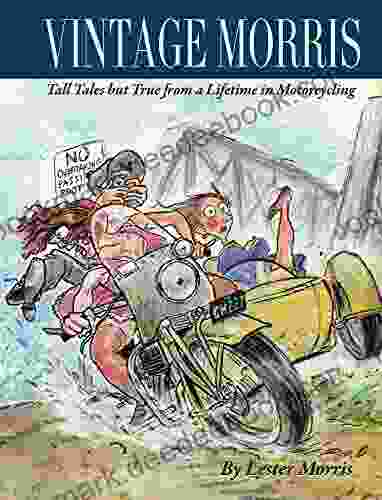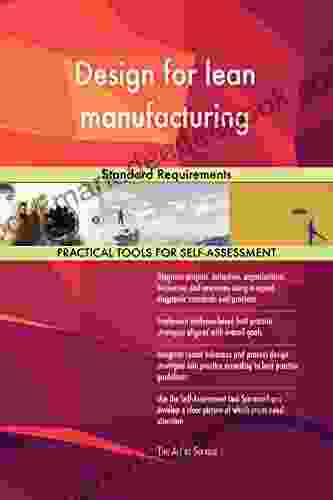Design for Lean Manufacturing: Standard Requirements for Enhanced Production Efficiency

In today's competitive manufacturing landscape, optimizing production efficiency is paramount to achieving sustained success. Design for Lean Manufacturing (DFLM) has emerged as a powerful approach that enables manufacturers to eliminate waste, improve flow, and enhance overall productivity.
DFLM is a systematic methodology that focuses on aligning product design with lean manufacturing principles. By incorporating lean standards into the design process, manufacturers can create products that are easier to produce, assemble, and maintain.
5 out of 5
| Language | : | English |
| File size | : | 298 KB |
| Text-to-Speech | : | Enabled |
| Screen Reader | : | Supported |
| Enhanced typesetting | : | Enabled |
| Word Wise | : | Enabled |
| Print length | : | 314 pages |
This article explores the standard requirements for DFLM, providing a comprehensive guide to implementing this transformative approach in manufacturing operations.
Key Standard Requirements
The following standard requirements form the foundation of DFLM:
1. Value Stream Mapping
Value stream mapping is a visual representation of the flow of materials and information through a manufacturing process. It helps identify areas of waste and inefficiency, allowing manufacturers to optimize the flow and reduce lead times.
2. Just-in-Time Manufacturing (JIT)
JIT is a production strategy that eliminates waste by producing only what is needed, when it is needed. It requires close coordination between suppliers, production, and customers to ensure smooth and efficient flow.
3. Single-Piece Flow
Single-piece flow is a manufacturing technique that involves producing products one at a time, eliminating inventory buildup and reducing lead times.
4. Standardized Work
Standardized work is a set of instructions that define the optimal way to perform a task. It ensures consistency, improves efficiency, and minimizes errors.
5. Continuous Improvement
Continuous improvement is an ongoing process of identifying and eliminating waste, improving processes, and enhancing productivity. It involves regular audits, feedback, and employee engagement.
6. Quality Assurance
Quality assurance is essential in DFLM to ensure that products meet customer specifications and standards. It involves rigorous inspections, testing, and process control to prevent defects and maintain product quality.
Benefits of DFLM
Implementing DFLM standard requirements offers numerous benefits, including:
1. Reduced Waste
DFLM eliminates waste by identifying and addressing non-value-added activities throughout the manufacturing process.
2. Improved Flow
By optimizing flow, DFLM reduces lead times, improves production efficiency, and enhances overall responsiveness.
3. Increased Productivity
DFLM empowers manufacturers to produce more with less, increasing productivity and profitability.
4. Enhanced Quality
The focus on quality assurance in DFLM ensures consistent product quality, reduces defects, and enhances customer satisfaction.
5. Continuous Improvement
DFLM promotes a culture of continuous improvement, leading to ongoing innovation and process optimization.
Implementation Considerations
Implementing DFLM standard requirements requires careful planning and execution:
1. Leadership Commitment
Successful DFLM implementation requires strong leadership commitment and support from all levels of the organization.
2. Employee Engagement
Employees should be involved in the DFLM process, providing valuable insights and contributing to the improvement effort.
3. Training and Education
Training and education are essential to ensure that employees understand and embrace lean manufacturing principles.
4. Metrics and Measurement
Regularly measuring and tracking performance metrics is crucial to assess progress and identify areas for further improvement.
Design for Lean Manufacturing is a transformative approach that empowers manufacturers to achieve significant gains in production efficiency, quality, and profitability. By adhering to standard requirements such as value stream mapping, JIT manufacturing, and continuous improvement, manufacturers can create products that are easier to produce, assemble, and maintain, while eliminating waste and improving flow.
Implementing DFLM requires leadership commitment, employee engagement, and a rigorous approach to continuous improvement. By embracing these principles, manufacturers can harness the power of lean manufacturing to gain a competitive edge and drive sustained growth.
5 out of 5
| Language | : | English |
| File size | : | 298 KB |
| Text-to-Speech | : | Enabled |
| Screen Reader | : | Supported |
| Enhanced typesetting | : | Enabled |
| Word Wise | : | Enabled |
| Print length | : | 314 pages |
Do you want to contribute by writing guest posts on this blog?
Please contact us and send us a resume of previous articles that you have written.
 Text
Text Library
Library Magazine
Magazine Newspaper
Newspaper Paragraph
Paragraph Sentence
Sentence Bookmark
Bookmark Shelf
Shelf Glossary
Glossary Bibliography
Bibliography Annotation
Annotation Scroll
Scroll Tome
Tome Classics
Classics Library card
Library card Biography
Biography Memoir
Memoir Reference
Reference Encyclopedia
Encyclopedia Dictionary
Dictionary Thesaurus
Thesaurus Resolution
Resolution Catalog
Catalog Card Catalog
Card Catalog Archives
Archives Periodicals
Periodicals Scholarly
Scholarly Reserve
Reserve Academic
Academic Journals
Journals Reading Room
Reading Room Interlibrary
Interlibrary Literacy
Literacy Study Group
Study Group Dissertation
Dissertation Awards
Awards Reading List
Reading List Book Club
Book Club Theory
Theory Textbooks
Textbooks Russ Manning
Russ Manning Mary Ann Warren
Mary Ann Warren Steven R Banks
Steven R Banks Edward P Johanningsmeier
Edward P Johanningsmeier David Foster
David Foster Suzanne Goldring
Suzanne Goldring Kurtis Scaletta
Kurtis Scaletta Anthony San
Anthony San Joan Singleton
Joan Singleton Maria Chivers
Maria Chivers Karen Jones
Karen Jones Fawn Amber Montoya
Fawn Amber Montoya Elizabeth Nickson
Elizabeth Nickson Cassandra Williams Edmond
Cassandra Williams Edmond Jeff Kinney
Jeff Kinney Tom H Hastings
Tom H Hastings Matt Grossmann
Matt Grossmann Sam Savage
Sam Savage Bobbi Holmes
Bobbi Holmes Jasmine Lee Jones
Jasmine Lee Jones
Light bulbAdvertise smarter! Our strategic ad space ensures maximum exposure. Reserve your spot today!

 Isaias BlairUnveiling the Enigmatic Blade from the Barrow High Fire: A Journey through...
Isaias BlairUnveiling the Enigmatic Blade from the Barrow High Fire: A Journey through... Jack PowellFollow ·14.7k
Jack PowellFollow ·14.7k George HayesFollow ·14.9k
George HayesFollow ·14.9k Cristian CoxFollow ·15.8k
Cristian CoxFollow ·15.8k Kazuo IshiguroFollow ·16.2k
Kazuo IshiguroFollow ·16.2k Nathaniel HawthorneFollow ·17k
Nathaniel HawthorneFollow ·17k Blake BellFollow ·5.1k
Blake BellFollow ·5.1k Jerry WardFollow ·18.3k
Jerry WardFollow ·18.3k Juan RulfoFollow ·19.1k
Juan RulfoFollow ·19.1k

 Oscar Wilde
Oscar WildeDon't Stop Thinking About the Music: Exploring the Power...
Music is an...

 Floyd Richardson
Floyd RichardsonSnowman Story Problems Math With Santa And Friends
It's a cold winter day, and...

 W. Somerset Maugham
W. Somerset MaughamWhat Every Classroom Teacher Needs To Know: A...
Teaching is a challenging...

 Edgar Cox
Edgar CoxTall Tales But True: A Lifetime of Motorcycling...
I've been riding motorcycles for over 50...

 Chinua Achebe
Chinua AchebeBuni: Happiness Is a State of Mind
Buni is a beautiful...

 Herman Melville
Herman MelvilleThe Arts and Crafts of Older Spain: Embodying the Essence...
In the heart of the Iberian...
5 out of 5
| Language | : | English |
| File size | : | 298 KB |
| Text-to-Speech | : | Enabled |
| Screen Reader | : | Supported |
| Enhanced typesetting | : | Enabled |
| Word Wise | : | Enabled |
| Print length | : | 314 pages |










